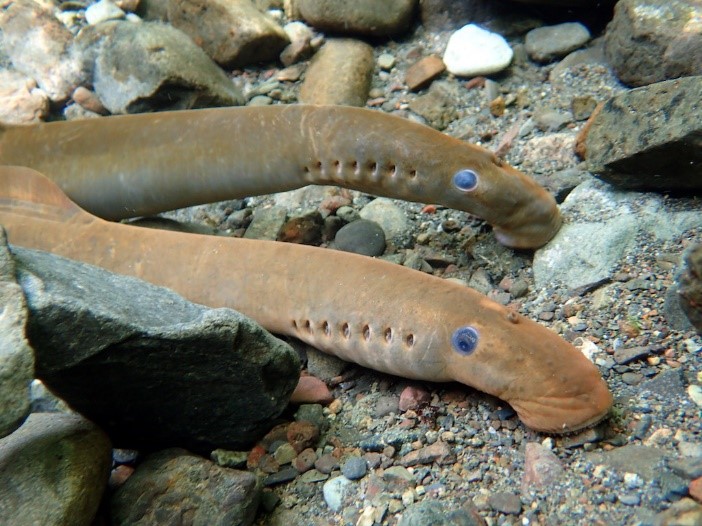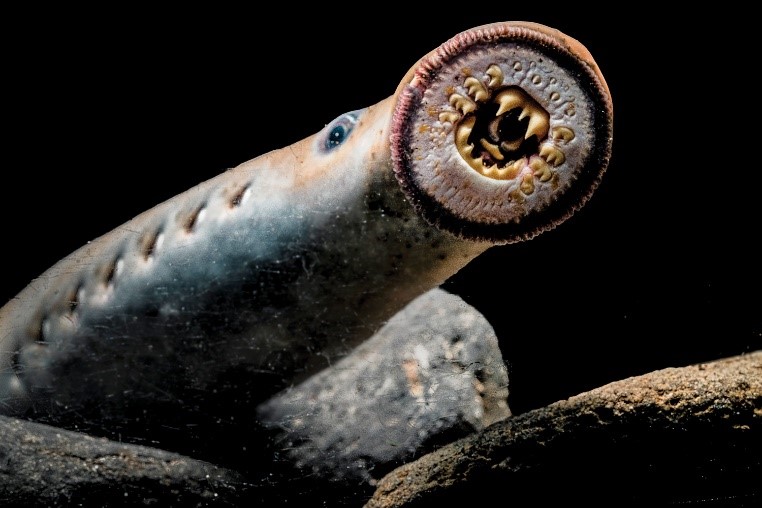Description

Disclaimer: Copyright infringement not intended.
Context
- Two potential new species of lamprey fish have been discovered in California waters.
READ ALL ABOUT LAMPREYS: https://www.iasgyan.in/daily-current-affairs/lamprey
Lamprey Fish:
Introduction:
- Lampreys are jawless fish belonging to the superclass
- They are characterized by a distinctive, eel-like appearance and a toothed, funnel-like sucking mouth.

Disclaimer: Copyright infringement not intended.
Physical Characteristics:
- Elongated Body: Lampreys have long, cylindrical bodies, typically resembling eels.
- Lack of Scales: Unlike most fish, lampreys lack scales on their skin.
- Jawless Mouth: They possess a circular, jawless mouth filled with sharp teeth used for feeding.
Life Cycle:
- Anadromous Behavior: Lampreys often exhibit anadromy, migrating between freshwater and the ocean during different stages of their life cycle.
- Amphihaline Species: Some lamprey species are amphihaline, completing their life cycle entirely in freshwater.
Feeding Habit:
- Parasitic Stage: Adult lampreys are often parasitic, attaching themselves to other fish by using their oral disc to feed on their host's body fluids and tissues.
- Filter Feeding: Larval lampreys, called ammocoetes, are filter feeders, consuming small particles and microorganisms.
Habitat:
- Lampreys inhabit a variety of aquatic environments, ranging from freshwater rivers and lakes to coastal areas and the open ocean.
Economic Importance:
- Cultural and Culinary Uses: In some cultures, lampreys have culinary significance and are consumed as a delicacy.
- Research Value: Lampreys are of scientific interest for studies on vertebrate evolution due to their unique characteristics.
Reproduction:
- Lampreys typically reproduce through external fertilization, with females depositing eggs and males releasing sperm simultaneously.
Conservation Status:
- Some lamprey species face conservation challenges due to habitat loss, pollution, and barriers to migration, leading to efforts to protect and restore their habitats.

Notable Species:
- Sea Lamprey (Petromyzon marinus): A well-known lamprey species with an anadromous life cycle, found in North America and Europe.
Cultural Significance:
- Lampreys have cultural significance in various societies, featuring in folklore, mythology, and historical narratives.
Medical Research:
- Due to their unique immune system and resistance to certain diseases, lampreys are studied for potential applications in medical research.
Control Measures:
- In regions where lampreys pose a threat to native fish populations, control measures, such as barriers and traps, are implemented.
Ecosystem Benefits of Lamprey Fish
- Water Quality Improvement: Lamprey larvae play a crucial role by filtering and feeding on algae and organic matter, contributing to enhanced water quality in their habitat.
- Stream Maintenance: The presence of lamprey larvae helps maintain streambeds, ensuring the stability and ecological health of freshwater ecosystems.
- Nutrient Cycling: Lamprey larvae contribute to the cycling of nutrients in aquatic systems, fostering a balanced and sustainable environment.
- Nutrient Transport: Migrating adult lampreys transport essential nutrients after spawning, influencing nutrient distribution in aquatic ecosystems.
- Ecological Interactions: Birds, fish, and certain aquatic mammals rely on lamprey juveniles and adults as a food source, highlighting their significance in local food webs.
- Mutual Benefits: Conservation measures aimed at protecting lamprey populations also positively impact other species, such as trout, contributing to the overall health of ecosystems.
|
PRACTICE QUESTION
Q. Which of the following statements about lamprey fish is correct?
1.Lampreys belong to the superclass Osteichthyes.
2.Adult lampreys are herbivorous, feeding on algae and detritus.
3.Lampreys exhibit anadromous behavior, migrating between freshwater and the ocean during different life stages.
4.Lampreys have scales covering their skin similar to other fish species.
Select the correct answer using the codes below:
A) Only 1 and 2
B) Only 2 and 4
C) Only 3
D) Only 1 and 3
Answer: C) Only 3
Explanation
- Option 1 is incorrect because lampreys belong to the superclass Cyclostomata, not Osteichthyes.
- Option 2 is incorrect because adult lampreys are often parasitic, feeding on other fish, and not herbivorous.
- Option 3 is incorrect because lampreys lack scales on their skin, making them distinct from many other fish species that have scales.
- Option 3 is correct as lampreys do exhibit anadromous behavior, migrating between freshwater and the ocean during different stages of their life cycle.
In summary, the correct answer is C) Only 3, as it accurately represents the characteristics of lamprey fish.
|










